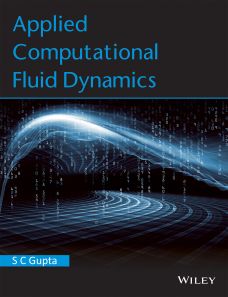Applied Computational Fluid Dynamics
ISBN: 9788126577538
316 pages
eBook also available for institutional users
For more information write to us at: acadmktg@wiley.com

Description
This book is intended for undergraduate and postgraduate students studying computational techniques. The book is application oriented as well as code-development oriented. It is focused towards inverse design and optimization methods. Emphasis is placed on efficient algorithms development and parallel computing. While Chapter 1 is introductory about the flow physics, Chapter 2 is about discretization of domains and stability of marching schemes. Chapter 3 describes the finite difference discretization, numerical features of schemes including issues related to conservative smoothing and implicit nature of unsteady problems. Chapter 4 is about structured and unstructured grid generation methodologies including surface grid generation.
Chapter 1 Introduction
1.1 Insight into Power of Computational Fluid Dynamics
1.2 Advantages of CFD
1.3 Typical Major Goals of Computational Numeric in Aerospace
1.4 Error Sources in CFD Codes and in Wind Tunnel Data
1.5 Requirement of Computing Power for CFD
1.6 CFD Applications
1.7 CFD Ideas to Understand
1.8 Models of Flow
1.9 Substantial Derivative (Time Rate of Change Following a Moving Fluid Element)
1.10 Divergence of Velocity (∇ ⋅ V )
1.11 Compressibility
1.12 Viscosity
1.13 Governing Equations of Flow
1.14 All Equations Are One: Some Manipulations
1.15 Integral Versus Differential Form of Equations
1.16 Comments on the Governing Equations
1.17 Physical Boundary Conditions
1.18 Forms of Governing Equations Particularly Suited for CFD Work
1.19 Shock Fitting and Shock Capturing
Chapter 2 Mathematical Behavior of Partial Differential Equations and Its Impact on Computational Fluid Dynamics
2.1 Introduction
2.2 Method to Determine Classification of Partial Differential Equations
2.3 Classification of PDEs: Impact on Physical and Computational Fluid Dynamics
2.4 Essence of Discretization
2.5 Difference Equation
2.6 Explicit and Implicit Approach
2.7 Errors and Stability Analysis
2.8 Stability Regions of Standard Time-Stepping Techniques
2.9 System of Second-Order PDEs
2.10 Canonicalization of PDEs
Chapter 3 Solution Methods of Finite-Difference Equations
3.1 Introduction
3.2 Time Marching
3.3 Space Marching
3.4 Relaxation Technique
3.5 Alternating Direction Implicit (ADI) Method
3.6 Successive Over-Relaxation/Under-Relaxation
3.7 Lax−Wendroff Method
3.8 Upwind Schemes
3.9 Midpoint Leapfrog
3.10 Shock Capturing
3.11 Numerical Viscosity
3.12 Artificial Viscosity
3.13 Conservative Smoothing
3.14 Unsteady Problem-Explicit versus Implicit Scheme
Chapter 4 Grid Generation
4.1 Introduction
4.2 Structured Grid Generation
4.3 Surface Grid Generation
4.4 Multiblock Grid Generation
4.5 Unstructured Grid Generation
4.6 Multigrid Methods: Cycling Strategies
Chapter 5 Adaptive Grid Methods and Appropriate Transformation
5.1 Introduction
5.2 Adaptive Grids
5.3 Structured Grid Adaptive Methods
5.4 Unstructured Adaptive Grid Methods
5.5 General Transformation of the Equations
5.6 Matrices and Jacobians
5.7 Generic form of the Governing Flow Equations in Strong
5.8 Parallel Processing
Chapter 6 Finite Volume Methods
6.1 General Conservation Laws
6.2 Spatial Discretization – Structured Finite Volume Scheme
6.3 Temporal Discretization – Structured Finite Volume Scheme
6.4 Boundary Conditions
6.5 Case Studies
6.6 High-Resolution Schemes
Chapter 7 Computational Fluid Dynamics: Some Applications
7.1 Numerical Dissipation and Dispersion
7.2 Approximate Factorization
7.3 Flux Vector Splitting
7.4 Computational Solution for the Laminar Boundary Layer
7.5 Application to Turbulence
7.6 Computational Solution for Turbulent Boundary Layer
7.7 Thermal
7.8 Multi-Objective Shape Optimization
7.9 Inverse Design
7.10 Similarity Laws
7.11 Method of Characteristics
7.12 Fluid Structure Interaction
Appendix 7.1
Appendix 7.2 Design Exercise: To Design Three-Dimensional Aerofoil Shapes for Maximum Endurance for Jet-Powered Plane
References
Index

